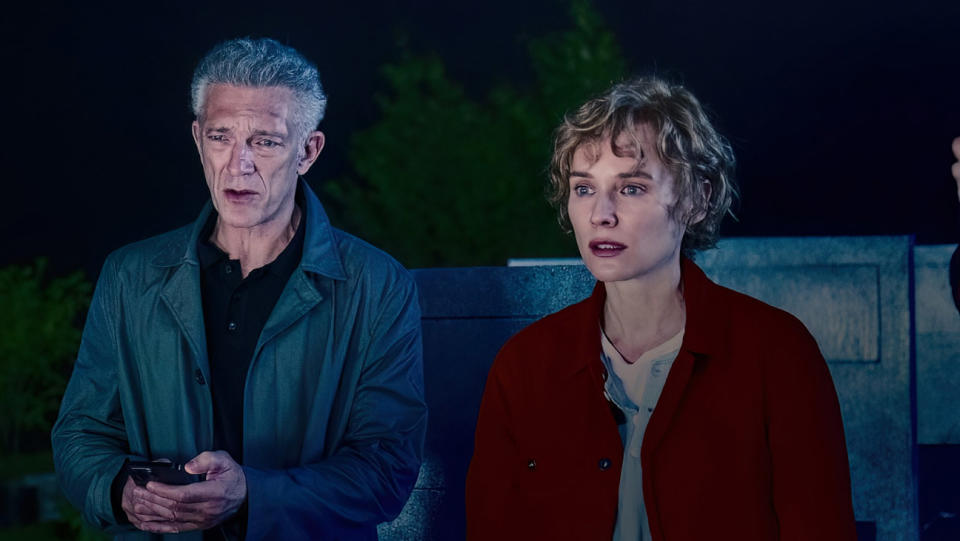Ontario’s Behind-the-Camera Talent Boom Sparks Hollywood Collaborations With Global Impact

Ontario talent has long starred onscreen in Hollywood, from Ryan Gosling and Mike Myers to Rachel McAdams and Sandra Oh.
But just as the province has become a key Hollywood production hub for the major studios and streamers, top global film and TV producers are also embracing local below-the-line talent to realize their creative ambitions behind the camera.
More from The Hollywood Reporter
Toronto: Actress-Centric 'The Room Next Door' and 'Nightbitch' Premiere, Face Different Awards Paths
Amy Adams Tells 'Nightbitch' Premiere in Toronto: "I Freaked the Dogs Out on the Set"
Juliette Binoche Says She Felt "Brother and Sister" With Ralph Fiennes Reuniting for 'The Return'
“When the amazing shows come and they bring the crazy scripts and the ambitiousness of it all, we’re able to meet the challenge, which is satisfying to see,” Shayne Fox, who has just received her third Emmy nomination for her production design work on the series What We Do in the Shadows, tells The Hollywood Reporter about doing her best work in the FX sandbox.
From Francis Ford Coppola’s dystopian epic Megalopolis to Tim Burton’s Beetlejuice Beetlejuice, Ontario talent is bringing its A-game to some of the biggest titles of the fall, as the Canadian province and Hollywood’s biggest filmmakers increasingly and seamlessly intersect.
A key player in making this happen is the Directors Guild of Canada — Ontario. Besides negotiating the Standard Agreement, which governs pay and workplace conditions for its members on local and foreign productions, DGC-Ontario also does extensive skills training programs, industry and community outreach, and diversity and inclusion initiatives to ensure work for its below-the-line talent.
“We really have great talent that’s being recognized when it’s seen. The trick is getting it seen,” Directors Guild of Canada — Ontario executive director Victoria Harding tells THR.
Film editor Cam McLauchlin developed a shorthand with prominent Hollywood directors after he cut Coppola’s Megalopolis and Guillermo del Toro’s Nightmare Alley and Cabinet of Curiosities. “To work with directors like Guillermo and Francis is clearly a gift,” McLauchlin says.

He credits working with del Toro in the edit suite in varying roles since the Hollywood horror meister shot Pacific Rim in Ontario for getting him alongside Coppola for Megalopolis. “The city has been challenged by [del Toro’s] filmmaking abilities. A lot of people have risen to the occasion of working with someone with such a work ethic and creative mastery,” McLauchlin adds.
Coppola was a fan of Nightmare Alley, and so chose McLauchlin to cut his self-funded epic, which is set for a North American bow at TIFF. “Working with Francis was fascinating, bewildering, amazing, exhilarating, everything under the sun. He’s very collaborative, very open to experimenting and very open to letting the editor at that point do their thing,” says McLauchlin, who also cut Gia Coppola’s The Last Showgirl, another TIFF-bound title.
An exponential growth in below-the-line workers, such as cameramen and film and sound editors, has followed U.S. films and TV series being routinely shot in the Canadian province since the 1970s, with local talent getting work on those high-profile projects and homegrown films and TV series.
Other hotly tipped Ontario collaborators include film editor Jay Prychidny. He began working with Tim Burton on his stylized Netflix series Wednesday as the Batman and Edward Scissorhands director branched out into TV. Prychidny followed that up by becoming one of the filmmaker’s cinematic collaborators on Beetlejuice Beetlejuice, which recently received an enthusiastic response at its premiere in Venice.

“With all the people [Burton] works closely with, there’s a mind meld that happens. He likes to communicate using few words and work with people who understand what he means right away. So I had that connection, and I think that’s why he wanted me to continue working with him,” Prychidny recalls.
Chris Donaldson, editor on the Oscar-winning Women Talking for Sarah Polley and David Cronenberg’s The Shrouds, the Cannes competition title also screening at TIFF, says the success of both Canadian directors who shoot virtually all of their movies in Ontario has opened eyes in Hollywood to local talent.
“David helped create the idea that [Ontario] had that world-class talent here. The success of Sarah and the success of David means, as they raise financing outside the country, that they can feel their talent pool is in Canada,” Donaldson argues.
Cronenberg drawing from the talent pool certainly worked out well for Donaldson, who worked early in his career as an assistant to editor Ronald Sanders, a frequent collaborator with the auteur. When it came time to shoot Cronenberg’s 2022 sci-fi body horror Crimes of the Future, the director tapped Donaldson to cut it since Sanders was unavailable. “I never in a million years dreamed about the possibility of working with David this way. It’s just such an extraordinary privilege and so incredibly inspiring,” he explains.
Production designer Zosia Mackenzie will have a busy TIFF this year, having first worked in Budapest, Hungary, alongside three Canadian filmmakers — Guy Maddin and longtime collaborators Evan Johnson and Galen Johnson — on Rumours, the Cate Blanchett-starring absurdist comedy that included forest bog zombies and a giant brain made of foam interrupting a meeting of G7 Nation leaders that then spins out of control.

“I tried for that Guy Maddin look, and made it feel like it’s in studio, even though it was on location, with a lot of variables like the weather and the wind and even our pond scene, with our leader going into the water,” Mackenzie recalls of the Rumours shoot.
Closer to home, Mackenzie worked with Rachel Morrison, an American cinematographer known for her Oscar-nominated work on Mudbound and Black Panther, as she made her feature directorial debut with Ontario-shot The Fire Inside, which is getting a special presentation at TIFF.
For Mackenzie, the biopic about Claressa Shields and her true-life ascent to the Olympic boxing gold had mostly in-studio builds based on archival photos and an earlier documentary, T-Rex. That included a Flint, Michigan, boxing ring and equipment sourced stateside for authenticity, and Shields’ period childhood home re-created in Oshawa, Ontario. “Because we had access to a lot of those materials, it sort of made sense to us to build as much of it as possible,” she recounts.
Elsewhere, Joe Bracciale and his team are up for an Emmy for outstanding sound editing for their work on Fargo, which is shot in Calgary and does postproduction in Ontario. Working with showrunner Noah Hawley allowed wide latitude in creativity, Bracciale recalls, especially after he and his team earned an Emmy for their sound work on the second season.
“It means a lot when you get that recognition. Then other American producers aren’t afraid to come up and use us. I’d say we’ve gotten a lot more work because of winning that Emmy or even being nominated. People know that they’re obviously doing something really great up there,” Bracciale says.
Emmy wins and nominations also represent vindication for the long hours and effort put into their work.
“Everybody in this industry puts in a lot of long days and hours and weekends and stuff, so it’s just really nice to know, ‘Oh yeah, we’ve been recognized as doing something special.’ It’s great,” Bracciale adds.

DGC-Ontario’s Harding argues that local talent plying their trade on homegrown movies and TV series has made Ontario a cradle of Hollywood behind-the-camera star power.
“We approach things believing that we have a lot to learn, and we have learned over the years, not just from foreigners, also from within our own system,” she says. “Because even if the American work wasn’t here, we’d still have a domestic industry that’s providing a breeding ground for those talents to continue to emerge and be honed.”
Harding says the work the DGC-Ontario does to help below-the-line talent begins early, and it’s clearly paying off.
“We participate in a lot of outreach events and we’re going out to schools all over the province, we’re going to job fairs, we’re going to film schools to try to help people find their way through what can be daunting,” she says. “When I started the industry was niche, and now it’s a major industry with big needs.”
Best of The Hollywood Reporter
Sign up for Hollywoodreporter's Newsletter. For the latest news, follow us on Facebook, Twitter, and Instagram.
